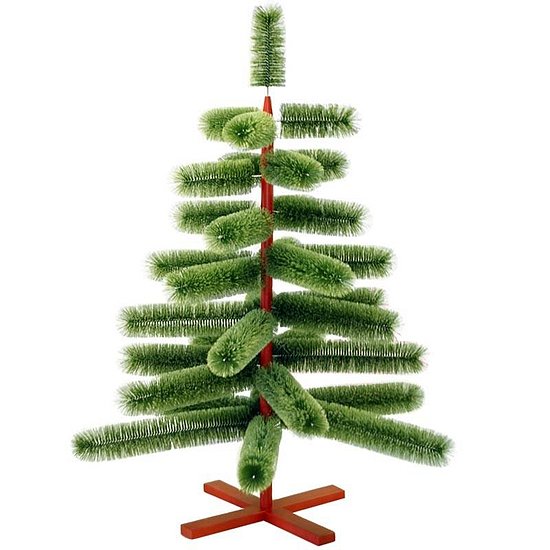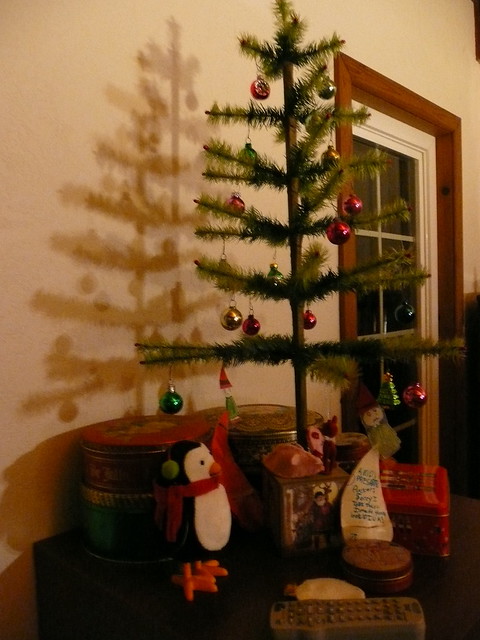 |
| A full-size white feather tree. From 1900-1915 the vogue for all-white trees with silver accents actually led to many Victorian-era glass and metal ornaments having their coloured paints washed off. Via goldenglow.org |
Feather trees were initially made as a response to deforestation in Germany, starting in the late 1800s, using dyed goose or turkey feathers, and sometimes silver or lead tinsel mixed with feathers or on its own. The branches on feather trees are straight and widely spaced (to reduce the risk of fires from the candles that were originally used to light them), which makes them ideal for displaying collections of large ornaments - but can also make them challenging to decorate. After World War I imposed difficulties on the import of German-made goods, feather trees were also manufactured in Britain. When most people think of antique trees, they think of feather trees, partly because American-made reproductions have been available since the 1980s. Feather trees are mostly sold in table-top sizes, because they're mostly being sold to ornament collectors who are following the
early-to-mid-Victorian custom of decorating a separate small tabletop tree for each family member (or each themed collection of ornaments) - oh, and because they're kind of expensive.
 |
The 2007 reproduction 58-inch bottle brush tree by Kuno Prey
is great fun partly because it scales up (WAY up) the proportions of the 1930s tabletop versions.
It looks modern and minimalist, but it's actually a throwback. Love it! via Casa Sugar |
Most
bottle brush trees for sale now are
miniatures or wreaths, but starting in the 1930s,
table-
top and
full-size versions were the US-made replacement for the German-made feather trees. The first manufacturer of bottle brush trees, Addis Brush Company (the American affiliate of the British company that invented the toothbrush), supposedly used the same equipment as used to make toilet bowl brushes to make the tree branches - a fact live-tree proponents
take such delight in repeating that I wonder about its truth. With no shortage of real trees in North America,
bottle brush trees were mostly exported to timber-starved Britain. The wire used for them was heavier, so bottle brush trees are said to have been less fragile than feather trees and better able to accommodate heavier decorations. Initially they were made of sisal, but cellulose and viscose bristles were also used, so sometimes they're listed as 'early plastic' trees by dealers. This is the kind of tree I remember my maternal grandparents using, with soft 'needles' and wire branches that actually branched and were fuller and more closely spaced than in earlier feather and bottle-brush trees.
Martha Stewart's done
a great article on the aluminum trees that debuted in the late 1950s - although it misses that
Addis also invented them. Aluminum trees were designed to be sparsely decorated, and were sold with rotating stands and lit with coloured floodlights. They were sold alongside bottle brush trees made in the same way as before, but with more modern materials like
vinyl (the PVC and tinsel trees sold today are still mostly made using a variant of the bottle brush technique). Flocked bottle-brush trees in unusual colours (including black) were introduced in the 1960s - but the flame-retardant flocking used tended to yellow badly, so it's hard to find these in good condition. I'm not sure I'd want to bring those flame retardants into my home anyway.
By the 1970s, there were also
injection-molded plastic trees; my parents had one of these, with brown hard plastic for the trunk and branches and green soft plastic needle clusters that slipped onto knobs on the branches. We decorated it well into the 1990s, mocking the telltale molding lines and flaps of extra plastic on the needles, and we found that by piling an exuberant amount of handcrafted ornaments onto the tree we could distract from its obvious fakeness. I can't find a closeup photo of these anywhere - I must ask my parents for an old photo of theirs - but you know how Playmobil make the plants that come with their hard-plastic playsets? Imagine that, writ large in soft plastic. Connoisseurs of kitch would love such trees, I think. However, the softness of the plastic probably meant it was PVC with a fair bit of phthalates and lead added, so it's probably just as well that these type of artificial tree are no longer in our homes.
I must have missed some artificial tree types; there must be more than three. I have also seen one reference to early tabletop trees made only of wood - if only I could find it again! - and I'd love to think that some of the
stunning wooden trees now appearing on design blogs are descendants of that tradition, if it existed. My paternal grandmother preferred a tabletop tree made of driftwood she collected at the beach and hung with garlands, and I'm sure many families have similar traditions of decorating a home-made artificial tree or large potted plant.
Did you grow up with an artificial tree? What did you love (or hate) about it?





No comments:
Post a Comment